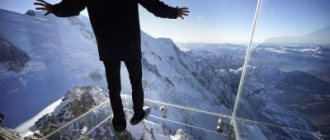Every minute, at every airport on the planet, an airplane with passengers on board takes off. 70% of people sitting in the cabin experience fear of flying, which is quite natural. But not everyone is able to cope with their phobia. To understand how not to be afraid of flying on an airplane, you need to understand the reasons for this fear.
Fear of flying
Causes of fear
Fear of flying on an airplane is a natural symptom characteristic of any person. Some people know how to drown it out and ignore it, while others, “making a mountain out of a molehill,” turn everything into a phobia. This happens for many reasons, and the roots of the problem lie in the subconscious.
- Reflexive fear is transmitted to people with a gene code from ancestors who were frightened by the first “iron birds”. For this reason, a person involuntarily shrinks when an airplane flies nearby;
- When an airliner takes off into the sky, the human body intuitively reacts with alertness - it has been torn out of its familiar environment. Those who are psychologically susceptible to phobias begin to get nervous and sometimes seriously panic, not always realizing the cause of their fear;
- Some people are afraid to fly on a plane consciously, having watched enough thrillers about plane crashes, although the real news is not full of daily reports about plane crashes. Such alarmists prepare themselves ahead of time for the tragedy of the situation;
- Usually people are afraid of flights carried out for the first time - here the fear of the unknown is frightening. There is also a category of people for whom the first flight was unsuccessful due to poor health on board. Mistaking severe motion sickness for danger, the subconscious imposed a taboo on this method of movement, and psychological perception turned it into a phobia.
Stress during flight
Note! Whatever the reason for fear when flying, you need to figure out how much of it is a phobia (or just an uncomfortable feeling of an unusual environment).
10 ways to overcome your fear of flying on an airliner
To get rid of aerophobia, you need to understand that any uncontrollable anxiety is caused by the expectation of negative events in the future. It is necessary to find out what exactly the anxiety is connected with and where the fear begins. To do this, you can do the following:
- An effective way to overcome the fear of flying is to analyze the real facts about statistics regarding the safety of air travel.
- Another method of coping with approaching aerophobia is to study positive aspects about the functioning of air transport. Avoid reading materials about plane crashes, “illiterate” pilots and poor technical condition of aircraft. Moreover, you can often encounter unreliable information that exaggerates the scale of the problem.
- What to do to prepare for air travel if you are scared to fly on an airplane? Create the most comfortable conditions for yourself, eliminating additional worries. Choose a convenient flight time, check in online to reserve a comfortable seat (for those who have a fear of flying, the best seats are located in the bow of the aircraft and near the wings), and arrive at the airport in advance. Don't sleep too much before traveling to be more likely to fall asleep in the aircraft cabin.
- A good way to overcome your fear of flying on an airplane is to think about the pilots and crew of the airliner. They have made flying their profession, they love it and are confident that they will do everything for your safety and theirs. Often, a good mood and a calm, confident appearance from the crew will significantly reduce the passenger's fears.
- You can overcome your fear of flying with the help of distraction. How a passenger struggles with unpleasant emotions - finds an interesting activity: reading a book, watching a video, talking with a fellow traveler.
- You need to fly in appropriate clothing: as comfortable as possible and not restricting movement, so as not to experience additional discomfort, which increases the discomfort of the flight. Have warm clothes on hand. Cold increases tension.
- To improve your well-being and maintain fluid balance, take water with you on board the aircraft.
- A proven way to get rid of aerophobia is using applications for mobile devices. With their help, you will be able to navigate in space: monitor the speed of the aircraft, flight altitude and other technical parameters. You will feel in control and find something fun to do.
- Many passengers experience particular fear from turbulence. This is a natural phenomenon and does not pose any obvious threats. Therefore, prepare yourself for possible shaking on board an airplane as normal flight realities.
- If simple methods do not help, contact a psychologist. He will tell you how to overcome your fear of flying and stop refusing air travel because of the fear of flying.
Symptoms
Can pregnant women fly on an airplane?
Aerophobia is not the only type of fear that people suffer from. There are those who are afraid of heights and confined spaces, as well as unfamiliar company. It is these fears that can cause a panic attack. To understand how aerophobic you are, you should try on the following symptoms of the problem described:
- You begin to feel fear of flying on an airplane long before the trip, and are unable to control your internal panic;
- Before you board the plane, you take a sedative dose of alcohol, sedatives or antidepressants;
- When an airliner takes off and lands, you unconsciously squeeze into the passenger seat, your palms sweat, and your fingers frantically dig into the armrests;
- During the flight, your entire consciousness is focused on monitoring the sounds of the engines. If the view of the window allows, you do not take your eyes off the running engines;
- If the plane gets into a zone of turbulence, the situation puts you in shock, and you mentally say goodbye to life;
- Every action of the flight attendant makes you suspicious, and you try to understand what she is hiding behind her smile.
Note! If you have even half of these signs, you are an aerophobe, for whom flying becomes a real punishment.
Manifestations of aerophobia
Aerophobia is characterized by a variety of physical, somatic and psychological symptoms. The manifestations of the first two include:
- Increased heart rate.
- Development of tachycardia.
- Pain in the chest area.
- Increased sweating.
- Vomiting and nausea.
- Frequent urination.
- Tension headaches.
- Redness or paleness of the face.
- Tremor of legs and arms.
You can determine whether a person has aerophobia based on a number of signs. The presence of an irrational fear of flying is indicated by the appearance of panic long before departure, suspicions that the flight attendant and pilots are hiding something, thoughts of inevitable death when the airliner encounters turbulence.
People with this disorder feel extremely uncomfortable throughout the entire flight, squeeze into the seat during takeoff and landing, and constantly listen to the operation of the engines, trying to hear signs of a breakdown.
Other psychological symptoms include:
- Increased irritability a few days before departure.
- Canceling a flight at the last minute.
- Categorical reluctance to use air transport.
- Obsessive thoughts about the plane crash.
- The use of special drugs for sedation.
Important! Prolonged stress after a flight also indicates aerophobia.
How to smooth the situation
At what age can you fly on an airplane without your parents?
When a person submits to his fears, it develops into a serious illness. If traveling by plane is not perceived as a natural event, it can be made more relaxed. To do this, you just need to distract yourself from your phobia by switching to something else.
Better relax
- Knowing about the upcoming flight, you can prepare for it in advance. You shouldn’t study reports about plane crashes that have already occurred; it’s better to look at the statistics of accidents occurring on Earth. Many more people die in DPT than in the air;
- To prepare yourself psychologically for the flight, it is advisable to register in advance and ask for a seat away from the windows. While the plane is loading, you calmly settle into your seat. You shouldn’t ask for space in the tail zone either – turbulence is most noticeable there;
- Before a flight, it is not recommended to calm yourself down with alcohol or serious drugs - they can provoke an inadequate reaction. Coffee, which has a stimulating effect on the psyche, will not help either. It is better to always have motion sickness pills and fruit lozenges with you;
- In order not to succumb to the phobia, you need to distract yourself, so you should take an interesting book or magazine with crossword puzzles on the road, download a movie with an exciting plot to your laptop or tablet, or occupy yourself with an exciting game;
- Listen to pleasant, soothing music coming from your headphones, it will help drown out the sounds of the engines. You can download a relaxation music library to your player especially for the flight;
- Chat with your seatmates. Talking is a good way to take your mind off your fears. Even if the same aerophobe as you is sitting next to you, mutual communication will help you cope with the problem;
- If you don’t want to have small talk or distract yourself from bad thoughts with idle activities, you can just sleep. To do this, just take an inflatable pillow and a blanket (as well as earplugs and a blindfold) into the cabin. If you forgot about this option, some airlines may offer you bedding;
- You don’t even have to sleep - you can just lie with your eyes closed and remember the pleasant moments of your life, think about an upcoming meeting, remember loved ones or make plans for the coming year.
Additional Information! Have you taken all the measures, but the state of panic does not go away? Then do some breathing exercises. The exercises are done like this: first, inhale deeply through your mouth, hold it in your lungs for 5 seconds, then exhale for another 4 seconds. don't breathe. Repeat the steps several times: this will help you calm down very quickly.
Why you shouldn't be afraid to fly on an airplane
The most common fears during a flight are the same for many people.
Turbulence Not a single plane crash has occurred due to turbulence; this condition does not threaten modern airliners, which are designed taking into account all physical phenomena and the effects of air flows.
Engine Failure Passenger airplanes have a glide system that is controlled by an autopilot. If all engines fail, although this situation is extremely rare, the aircraft will be grounded at the nearest airport or on the ground.
The plane is old and will break down. In aviation there is no concept of “old” or “new” plane. There are concepts of “serviceable” and “faulty”. Before the flight, each ship is checked; faulty aircraft are not allowed on the flight.
Pilots are drunk/out of their senses Pilots undergo a medical examination before departure, so this situation is impossible.
Pilots will begin to act recklessly. The actions of pilots are completely controlled by the “autopilot” system, which warns of errors.
They also want to live, so they do not intend to risk their lives. This should help remove the fear of flying. Such thoughts arise in any sane person. Just accept it as a fact that flying is much safer than driving a car. It is worth studying the statistics, which will show the real figure regarding flight safety.
Professional help
Why do you dream of flying on an airplane?
If fears of flying have been present for a long time, and traveling by plane is a frequent forced reality, you cannot do without the help of a specialist. It is worth paying serious attention to your psycho-emotional state, devoting enough time to it.
- Find an experienced psychologist who will help you figure out why you are afraid of flying and teach you how to deal with your phobia correctly. You can’t get rid of this with just a conversation - you’ll have to undergo a course of psychotherapy before you begin to perceive flying more naturally and stop being afraid of flying;
- Part of the treatment is the use of flight stimulators, which allow you to become accustomed to flying using virtual simulators. This point is good because in grounded conditions, in a specially equipped room, a feeling of the reality of flight is created;
- The doctor will help you choose medications for the upcoming trip. Here you need to take into account that the proposed pills are not a solution to the problem, but only part of the therapy, and they do not relieve the phobia on their own.
Virtual reality simulator
Medicines prescribed by a doctor for a flight can be divided into 2 types: cumulative and rapid-acting. The first group includes those that are accepted in several stages - immediately before departure, and then every half hour or hour. The second group of drugs has a sufficient concentration of sedative so that 1 tablet is enough for several hours of exposure.
Treatment is carried out with sedative and anti-anxiety medications that inhibit nerve impulses and relieve muscle spasms and cramps.
Important! The doctor himself decides which drug to treat an aerophobe, based on the individual characteristics of the patient, his state of mind, the causes of fear, and the severity of the problem.
You should not constantly resort to these means, since most of them can become addictive. This method of treating aerophobia should be short-term and applied to those who do not travel by plane very often.
The person himself can prepare for a future flight in advance. About 3 weeks before your upcoming trip, you can start taking glycine or valerian extract daily in the doses indicated in the instructions. This will help reduce nervous tension and avoid stressful situations.
How to overcome your fear of flying
In order to decide on a treatment strategy, you need to observe yourself and determine what nature the fear is. If what a person takes to be a phobia is ordinary anxiety, then you can overcome the fear on your own.
What the facts say
A person who wants to overcome aerophobia that interferes with his life must understand that the safest transport is an airplane. This is an axiom. The largest number of accidents and terrible deaths occur in motor vehicles. Statistics say that for 16 million km of distance traveled, the proportion of deaths is:
- 1.5 drivers of cars and trucks;
- 42 motorcyclists;
- 150 passengers.
About 30 thousand people die every year in Moscow accidents alone. The share of fatalities on the railway is 0.9 passengers per 16 million km.
In 12 months, about 5 billion passengers manage to use the services of air carriers. Statistics say that only 1 person out of 10,000,000 can die. Only those who board a random flight every day can become a participant in an air disaster.
Perhaps the following facts will help people who have a fear of flying to overcome aerophobia:
- Each system is equipped with 2 – 4 duplicates.
- The aircraft has numerous modern systems.
- The plane has 2 engines (simultaneous failure is almost impossible).
- If one of the engines fails, a modern aircraft can fly for 120 minutes and land softly.
- Before taking to the skies, each vehicle undergoes a thorough inspection by a team of highly qualified specialists.
Some people are helped to cope with aerophobia by realizing that every year air accidents are reduced by 15 percent, and passenger traffic increases by 10 percent.
Interesting video. Advice from a psychologist on how to stop being afraid of flying.
A plane crash usually results from not one, but a whole “bouquet” of reasons. Each reason is carefully analyzed in order to prevent a repetition of the tragedy.
How to help yourself
A person who has realized that his “phobia” turned out to be ordinary anxiety always wonders how to stop being afraid of flying without going to a psychotherapist and taking strong sedatives. It is recommended to do the following:
- arrive on time for check-in and boarding;
- ask for a place where turbulence is least felt;
- drink tomato or pumpkin juice during the flight;
- get carried away by an interesting book or solving a crossword puzzle.
For some people, being in a sterile area helps them calm down. In the huge window of the airport you can always see the “iron birds” taking off and landing safely. A person who does not know what to do with his fear should think of air transport as a routine. After this, aerophobia usually loses its position.
Don't keep fear to yourself. Some people find it helpful to talk to a neighbor. If you complain to a fellow traveler about the painful symptoms, he will find words of consolation or engage the person suffering from aerophobia in an interesting conversation. After this, the symptoms may also subside.
If neither being in a sterile area nor communicating with a neighbor helps to improve the condition, then you need to start doing light breathing exercises.
Breathing should be slow and deep.
Before doing the exercises, it is recommended to free your throat from any interfering accessories or collar. It is also recommended to direct the air conditioner air towards you. Usually after this there is an improvement.
What not to do
A person interested in the question of how to stop being afraid of flying should know what not to do during a flight.
It is not recommended to “drown out” fear by drinking alcohol. Alcohol exacerbates feelings and the condition of a person suffering from fear of air transport can only worsen. Some doctors believe that a drop of alcohol will not cause harm. But in practice, unfortunately, the matter cannot be solved.
It is also not recommended to take sedative and hypnotic medications uncontrollably. If the medications were not prescribed by the attending physician, they may contribute to overstimulation of the nervous system.
Laws of physics
Some people are terrified of flying precisely because they are cut off from the Earth. Not everyone understands the principle of aerodynamics, so they don’t fully understand how such a heavy metal colossus with a bunch of passengers on board and a large amount of luggage can stay in the air for several hours.
If you are flying for the first time, to calm your imagination and stop being afraid, it is worth familiarizing yourself with some design features of aircraft:
- Airliners are equipped with powerful engines that can not only lift a plane into the air, but also hold it for a long time among the clouds;
- There is no need to be afraid that the engines will break down: the plane has at least 2 of them. If 1 motor fails for some reason, the 2nd one will take over its function. Even if both engines fail at once, the plane will be able to land carefully, like a glider;
- The wings, which are quite firmly attached to the body, help the airplane stay and glide in the air. The chance that they will fall off in flight is reduced to zero;
- All systems equipped with airliners have duplicate programs. As soon as a failure occurs, the backup system immediately comes into operation (and there are at least 4 of them in passenger aircraft);
- You don’t have to worry about the risk of getting into a plane crash due to the pilot’s poor health - the planes have a reliable piloting system that allows you to carefully land the car according to the program built into it;
- The flight of each aircraft is controlled from the ground by air traffic control services, with which the pilots are in constant contact. Pilots will be immediately notified of all unusual situations and changes in weather conditions;
- The turbulence zone, which not every plane encounters, should not be scary. The aerodynamic parameters of the design are calculated taking into account this natural phenomenon, so that the aircraft has a sufficient margin of safety to withstand such shocks;
- There are professionals on board who do not consider themselves kamikazes. They calmly carry out their duties, as they are confident in the reliability of the “steel bird”.
Pre-flight technical inspection of the aircraft
Additional Information! For an extraordinary situation to occur, fate will have to try, because each plane is carefully checked by technical services before departure. They use special diagnostic devices, so faulty equipment will not even be allowed onto the runway. Customs inspection at the terminals has been strengthened, which prevents dangerous baggage from getting on board.
What to do if a child is afraid of flying
As we see, even adults suffer from a fear of air travel. Children also often face this fear, and its causes largely depend on age. Children from one to five years old sensitively capture the fears and emotions of their parents, completely focusing on them. If an adult panics, the child will support him in such an experience. In fact, it is not the flight itself that frightens children, but the stress of their parents.
Around the age of five, the fear of death appears. With a vivid and active imagination, children decide that airplanes are dangerous and begin to be afraid. The most common cause of children's fear is adults talking about flying in a negative way. For example, my mother tells how she was afraid to fly, learned to overcome her fear, and listened to stories about disasters.
In such circumstances, a child may well completely refuse to fly, not agreeing to fly even for the sake of interesting travel. Based on a small fragment of danger, a child's mind paints vivid and scary pictures.
Children often cry on an airplane, but the reasons may be different:
- The child was afraid of the unfamiliar surroundings, noisy neighbors, and the sound of the airliner engines.
- The baby could be hungry or simply tired from waiting for the flight.
- Young children often have blocked ears, and they do not yet know how to cope with this problem on their own. In this case, the mother's breast will help the newborn or infant. And for older children - lollipops for sucking during takeoff.
- Fear can be associated with past negative impressions, fear due to turbulence in a previous flight.
Children's fear of flying may be associated with other reasons. Here it is best to talk to the child, ask him why he does not want to go on vacation.
Parents can use tips on how not to be afraid of flying on an airplane and relieve children from fear. It is better to start preparing in advance:
- Tell as colorfully as possible about the benefits of the upcoming trip.
- Focus your child’s attention on the most pleasant moments that await him on vacation.
- Tell us in more detail about all stages of the flight, from check-in and waiting for departure to landing.
- Explain the rules of conduct on an airplane.
- Play pilot, flight attendant.
- Talk about birds that are constantly in the sky and enjoy flying.
- You can tell older children about the safety of airliners, take them on an excursion to the airport, and show them how planes take off and land.
We need to figure out what the child will do during the flight. It should be something that can seriously interest and captivate him: cartoons, board games, reading. For kids, you can take stickers or pencils, ready-made sets of travel games.
Parents will also need some work on themselves if they have any form of fear of flying. You need to learn to restrain your own negative emotions. Under no circumstances should you convey fear, discuss flying as something scary, or watch stories about disasters on TV. It’s better to tell your children how interesting it is to spend time on board and what views you can see from the window.
It is advisable for a child to choose a seat near the aisle so that the view from the window does not frighten him. An interesting conversation, playing on the phone, and getting to know other little passengers help you forget about unpleasant experiences. You can prepare some kind of surprise for your child and give it to him on the plane. For example, a toy that a child has long dreamed of will distract his attention from unnecessary fears.
Important! You can’t focus on the flight; it’s better to talk about what awaits you after landing.
Advice from the “experienced”
Don’t be shy to admit to others: “I’m afraid to fly on an airplane.” Among your friends there will be people who have already flown several times. They know what to do to overcome their fear. Take their advice to heart.
You will also be impressed by the reviews of third-party people who have learned to subdue their fears:
- Dmitry: “I used to be afraid of flying on an airplane, although I could not understand the reasons for this. On one of my business trips I fell in love with a beautiful girl. Now I fly to her on a date every Friday. During the flight, I only think about the upcoming meeting, making plans for how we will spend our time. Now, while I’m on board, I’ve never had a feeling of anxiety or panic”;
- Olga: “I am constantly overcome by some kind of fear. I am not comfortable in enclosed spaces, I am terrified of getting into a plane crash. Because of this, I lost a very profitable job - in our business, even minutes matter. Airplanes, the best option for mobility, allow you to quickly solve problems. I used the car exclusively, losing time and clients. As a result, I had to see a psychotherapist and undergo special training. Even now, I am periodically driven by unconscious emotions, but I try to control them. Realizing that phobias are a game of my subconscious, I took the risk of using the airline’s services and have already managed to make 2 flights.”
During turbulence
Many passengers do not endure the flight itself so much as the turbulence. Although, when you are driving a car and the road gets rough, you don’t start worrying about getting into a fatal accident.
You try to double your vigilance. It's the same with an airplane. He simply ends up in air pockets that he couldn’t get around. The plane itself will not fly into the area of thunderclouds, but will try to miss it.
The aircraft is not afraid of turbulence due to its perfect design.
Any aircraft is thoroughly tested before it is sent into service, so that it can withstand very heavy loads. What can we say about some thunderclouds or wind?
Sometimes the turbulence can be very strong. In this case, things fall from the shelves above, and the plane can even shake. This is no reason to panic!
If the phobia is not treated
When it is impossible to avoid flying, and you are terrified of it, problems not only of a psychological nature begin. If you do not learn to cope with fears, the phobia completely absorbs the person, turning him into a gloomy neurasthenic.
- Before an upcoming flight, a person begins to be overcome by panicky thoughts, as a result he is tormented by nightmares, or he cannot sleep at all;
- Becoming irritable and sleep-deprived, the aerophobe lashes out at people close to him, causing family relationships to deteriorate;
- Those who hide their fears find it even more difficult to endure flying. A phobia driven deep into oneself leads to the development of heart disease, hypertension, and heart attacks;
- If the need to fly is related to professional activities, every attempt to delay the flight or replace it with another type of movement affects career growth. Psychological shocks on this occasion make the aerophobe a patient in the neurological department;
- The fear of using the services of airlines impoverishes your vacation - not every resort can be quickly and easily reached by rail (let alone by car).
Important! Any type of phobia will progress quickly if you subordinate your psyche to it and refuse the help of professionals.
Hoping that he can cope on his own, a person resorts to using powerful psychotropic drugs or alcohol. The more often the need to fly arises, the faster the bad habit develops. Such doping does not make the situation easier, but makes it even worse.
Alcohol in conditions of low pressure and dry air in the aircraft cabin can cause lightheadedness (sometimes with vomiting). The body is in a suspended state, and even a small amount of alcohol at an altitude of several thousand meters from the Earth can cause severe intoxication, which results in loss of strength. This immediately worsens a drunk person’s mood, and panic sets in with even greater force.
Extreme option
Everything is known by comparison; it is difficult to challenge this postulate. Almost every major city has a flying club. You can easily ask an experienced pilot as a passenger to stop being afraid of flying.
Aerobatics and the roar of the engine a few centimeters from the body are a huge adrenaline rush. After a loop on a fighter jet, the air pocket on a passenger airliner will seem like a child's walk. You may not feel the speed in the cabin at all, especially after the view from the cockpit.
This extreme way of combating aerophobia will only help those who are only a little afraid of airplanes. A person with panic fear may not survive such an experiment. Not everyone can look fear in the eye, but if you do, flying will turn into real pleasure.
How to sleep on board an airplane
The second remedy for in-flight anxiety is sleep. If I can’t sleep, then I tire my autopilot with music, and the more rhythmic and louder it is, the faster sleep will come. Rhythmic and deep breathing with pauses can help. How they teach in yoga.
You can try sedatives, which are now sold in pharmacies - they are marketed specifically for sleeping on an airplane. I haven't tried it myself, I don't know. But you can read about it at the Vinsky Forum.
Some people rely on alcohol, but I don't want to recommend the "get yourself drunk and fall asleep" method. This threatens those who fly a lot or sit a lot due to their occupation - thrombosis of the veins of the lower extremities.
Breathe evenly
The suitcases are packed, the vouchers are purchased, but the passengers are in trouble. To relieve tension in the body, the expert advises using breathing techniques. “You need to do several breathing cycles, and the exhalation should be longer than the inhalation. Try to breathe not superficially, but more deeply, with your stomach. Place your hand on your stomach, and you will feel how the air fills you and frees you,” suggests Irina Frolova.
When performing the exercise, the specialist advises focusing on breathing. All thoughts should be put aside and allowed to take their course, like clouds in the sky. You just need to watch how the air slowly enters and leaves the body freely. This technique can calm the nervous system, level out an elevated pulse and calm an agitated heart.
In addition, according to the expert, there are many different points in our body, by influencing which with massage movements we initiate self-regulation without any drugs. In particular, these are the “reset buttons” that are located under the collarbones. They switch the nervous system, mobilize our brain to think clearly and force energy to move in the right direction. The psychologist recommends massaging such points for at least 30 seconds on each side.
“You need to make a “pistol” out of your fingers - connect your index and middle fingers, and put your thumb aside, as if you are showing “class.” Then feel the dimples under the collarbone. Press your fingers into them and massage these points with pressing movements. Place your other hand on your stomach near the navel to feel the air movement. Inhale through your nose and exhale through your mouth. The exhalation should be longer than the inhalation. Swap your hands - this is necessary for the integration of the left and right hemispheres and the body,” the psychologist recommends.
On board, to distract yourself, you need to take your favorite books, a selection of films, a playlist or some kind of game. You should choose clothes that are as comfortable as possible, loose and not tight.
Photo: depositphotos/Rosinka79
Getting rid of fear - knowing how an airplane works
Another pill for the fear of flying is knowledge of the basics of aerodynamics and design features of the aircraft.
Airplanes were born to fly. For a plane to forget how to fly, you have to try very, very hard.
Well, then - what are they afraid of! You voluntarily entered it, entrusting your safety to the pilots and with your fear you will not help them hold the helm.
Modern airplanes are automated so that they can land themselves. And the fact that sometimes during a flight an airplane flaps its wings—that’s why birds flap their wings, and that’s why they fly.











